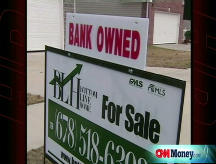Extending the mortgage-crash pain
Modification seems like a great idea now, but it may not help Wall Street or the economy in the long run.

NEW YORK (Fortune) -- Mortgage debt backs a lot of the bad bonds that are wreaking balance-sheet havoc, and mortgage relief has been suggested as a cure - both for homeowners and Wall Street. But a closer look suggests that modifying homeowners' loans may simply be pushing losses into the future.
Since the turmoil in the credit markets began a year ago, investment banks have had to write down the values of all sorts of securities, but the bonds that sparked the crisis were those backed by mortgages granted to borrowers who could ill afford the payments.
New foreclosure data due out Thursday should show even more homeowners underwater, so it's clear that mortgage debt is still toxic for investment banks, hedge funds and other institutional investors.
For them, loan modification holds out a ray of hope. Even though principal and interest payments will likely go down, that's better than foreclosure and no money at all coming into the bond.
Of all the mortgages that will go into delinquency over the next 12 to 18 months, as many as two thirds could be modified, Joseph Mason, an economics professor with the University of Louisiana who focuses on the mortgage markets, wrote in a report last fall.
About 1.7 million homeowners have received help negotiating with lenders through a government program called Hope Now; and the need for modifications is growing. Treasury Secretary Henry Paulson said recently that 1.5 million home foreclosures were started in 2007 and that an estimated 2.5 million more would take place this year. Congress is now debating an expanded federal role in the modification process.
Unfortunately, modification often isn't the end of the story. A survey by the Mortgage Bankers Association based on foreclosure information from the third quarter of 2007 shows that 29% of modified loans end in foreclosure anyway.
Predictably, the numbers are much higher for poorer states such as Arkansas (41%), Louisiana (42%), and North Dakota (47%). Before it filed for bankruptcy last year, loan originator New Century Financial stated that between 40% and 60% of loans it modified eventually ended up in foreclosure.
The housing stimulus bills working their way through Congress try to address this problem by providing a safe harbor for loan servicers that create "qualified loan modification or workout plans." A qualified plan is one that is scheduled to remain in place until the borrower sells or refinances, or for at least five years, and does not result in the borrower paying additional fees.
These measures should make loan servicers more careful about which loans they will modify. The servicers also would agree to take a 15% haircut on the value of the mortgage before selling the loan (and its risk) to the Federal Housing Authority (and the taxpayer).
For now, loan servicers are not regulated and historic data has not been compiled to see which companies have a better or worse track record when it comes to modification, points out Josh Rosner, managing director at research firm Graham Fisher.
Rosner says that, on average, a homeowner who had a loan modified only to lose the house in foreclosure paid the new loan for two years. Clearly the homeowner would have been better off renting and rebuilding his credit, says Rosner
But in the meantime, the mortgage payments help support the value of mortgage-backed bonds.
"You can imagine that if some of these mortgages are retooled, and especially if some are eventually given a Federal Housing Authority wrapper, they will rise in value," says Joe Patire, head of fixed income trading and managing director at YieldQuest.
He adds that in 2009 and 2010, many of the current write downs could become "write ups" as the market value on all that paper rises.
However, if 30% or 40% of these modifications end in foreclosure anyway, the losses will come, they'll just show up later.
"There might be an initial pop in price when these securities initially look like they will perform better," Patire says. "In reality, the holders of these securities will still be in the same place they were before. But something that has been written up is a lot easier to sell."
Wall Street, no doubt, would welcome any measure that allows it to get rid of these bonds for more than their current fire-sale prices, even if the bonds won't perform well down the road.
It's just a matter of finding a sucker to buy. Recent history has shown that to be a surprisingly easy feat to accomplish. ![]()
-
 The retail giant tops the Fortune 500 for the second year in a row. Who else made the list? More
The retail giant tops the Fortune 500 for the second year in a row. Who else made the list? More -
 This group of companies is all about social networking to connect with their customers. More
This group of companies is all about social networking to connect with their customers. More -
 The fight over the cholesterol medication is keeping a generic version from hitting the market. More
The fight over the cholesterol medication is keeping a generic version from hitting the market. More -
 Bin Laden may be dead, but the terrorist group he led doesn't need his money. More
Bin Laden may be dead, but the terrorist group he led doesn't need his money. More -
 U.S. real estate might be a mess, but in other parts of the world, home prices are jumping. More
U.S. real estate might be a mess, but in other parts of the world, home prices are jumping. More -
 Libya's output is a fraction of global production, but it's crucial to the nation's economy. More
Libya's output is a fraction of global production, but it's crucial to the nation's economy. More -
 Once rates start to rise, things could get ugly fast for our neighbors to the north. More
Once rates start to rise, things could get ugly fast for our neighbors to the north. More










